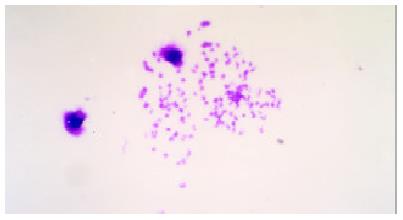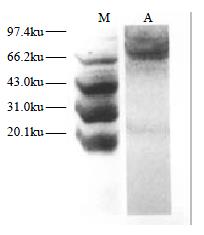Copyright
©The Author(s) 2002.
World J Gastroenterol. Oct 15, 2002; 8(5): 808-814
Published online Oct 15, 2002. doi: 10.3748/wjg.v8.i5.808
Published online Oct 15, 2002. doi: 10.3748/wjg.v8.i5.808
Figure 1 Morpholoical changes of HCC-9204 cells treated with 60 mL•L-1 etjanol for 6 h TEM × 6000
Figure 2 Detection of HCC-9204 cells treated with 60 mL•L-1 ethanol for 6 h by TUNEL assay × 200
Figure 3 DNA contents of HCC-9204 cells treated with 60 mL•L-1 for 6 h.
A: Non-treated HCC-9204 cells; B:HCC-9204 cells treated with 60 mL•L-1 etjanol for 6 h.
Figure 4 Monoclonal hybridoma cells growing in culture well.
× 100.
Figure 5 Immunocytochemical localization of the prepared mAb in HCC-9204 cells treated with 60 mL•L-1 ethanol for 6 h.
ABC × 200.
Figure 6 The chromosomes of the hybridoma cells which secrete objective mAb.
× 200.
Figure 7 The molecular mass of the associated antigen of the prepared mAb.
M: Standard molecular mass; A:HCC-9204 cells treated with 60 mL•L-1 ethanol for 6 h.
- Citation: Yang LJ, Wang WL. Preparation of monoclonal antibody against apoptosis-associated antigens of hepatoma cells by subtractive immunization. World J Gastroenterol 2002; 8(5): 808-814
- URL: https://www.wjgnet.com/1007-9327/full/v8/i5/808.htm
- DOI: https://dx.doi.org/10.3748/wjg.v8.i5.808















